Adventures in Christmas baking: Dutch kerstol
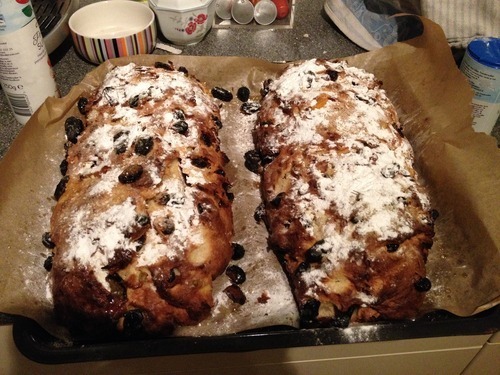
I spent a good chunk of the day yesterday cooking these badass Christmas breads. I wanted to do something that closely follows the Dutch kerststol that are usually shared on Christmas day breakfasts but with a twist: I wanted to try how they would come out with sourdough rather than with regular yeast. The answer is wonderful and delicious and OMG I want to stuff my face into them.
Since there are very few Dutch sites documenting this process (something that kinda surprised me given how this is a staple of Dutch cuisine), I am throwing some photos and commentary under a cut so as not to clog with my terrible food photography. My photos are beyond awful but that’s mostly because I don’t bother with proper photo technique, which is an art in itself. I live with a professional photographer and there’s enough with one of us for this entire household. I love to take photos just for the immediacy of sharing them (either with my family, friends or social media) and just want to capture a moment rather than focus on making things nice. As I said, food photography (or better said, photography in general) is an art. What you are about to see is not. My Christmas bread is also not art. It’s a face stuffing worthy wonder that I wish I could slice and share with all of the internet.
Now this is the part where being who I am, I write about food and cooking but I need to insert a few disclaimers and commentary. I read a lot about food on the internet. I read not only about restaurants or places to eat but mostly, cooking blogs. And there is one constant that peeves me in the culture of cooking blogs: how they rarely mention that cooking is expensive. I cook a lot, I’d say. I bake as well. However, I do not view home cooking as a viable alternative to industrially/ mass produced food. It is impossible to compete with the costs. Do not get me wrong, I love doing it but the claim that making a pasta dish at home, from scratch is always the best option is a myth and I’d go as far as saying a lie. It can be incredibly rewarding but it is expensive, time consuming and it takes a huge amount of resources both in terms of cooking equipment but also physical demands outside the scope of many, many people with different (dis)abilities. It also requires cultural capital. Cultural capital is not only about education. Sure, anyone who can read and write can see a recipe. However, following a recipe, even for beginners’ level dishes, requires more than reading and writing. It requires following instructions and having a basic grasp of how to create food. Home cooking culture (and yes, I do consider it a subculture in the political sense), more often than not erases all these intersections of ability, class, race, education, access to resources, ingredients and above all, the time required to make all of this happen.
All of this is a long winded way of saying that I really dislike the way that home cooking has been pushed as a viable and healthy alternative without a mere peep about all the different ways in which it remains out of reach for a vast sector of the population. Moreover, I deeply loath how home cooking has been gendered in a way that all of the above (which is not even a complete picture) falls into the laps of women who are subsequently blamed for obesity rates, children’s health issues, school performance problems for their children, etc etc. And, again, because we owe it to ourselves to look at all these issues from a multifaceted lens rather than the flattened view afforded by home cooking culture, hardly any of these food writers address how the access to resources and time disproportionately affect Women of Color, already burdened by institutionalized practices of employment discrimination and a pay gap that puts us at a disadvantage not only with white men and men of color but with white women as well. I might go out on a stretch here but, I see a lot of home cooking culture ideas as they are pushed in the mainstream (think Michael Pollan, Jamie Olivier -unsurprisingly, two white cis men, blaming women for the demise of society, etc) to be very closely tied to the raise of neoliberalism pushing individual solutions to systemic problems. Rather than demand a community wide solution, this subculture pushes for personal engagement, further burdening individual women with what should be a deep and systemic challenge to corporate practices in mass food production and how communities are left with hardly any alternatives between these two extremes.
Let me preface more about this Christmas breads with a little bit of personal history. A few months ago I became very intrigued and interested in sourdough (or zuurdesem, as it’s called in Dutch). I absolutely love the breads from Le Pain Quotidien but holly garbanzos are they expensive. At 9+ Euro per loaf, that’s not something I even consider a “treat”. It enters “designer goods” territory. So, I wanted to replicate the flavors and crust but I had no luck with regular, store bought instant yeast. Sure, the results were nice enough but they lacked in crust and texture. That’s how I found out about creating my own starter and going from there. A sourdough starter is, to put it in simplified terms, homemade yeast. It can take weeks to create a good starter, one that has both flavor and good rising properties. And that I did during the course of the past summer.
I started my sourdough project as a way to deal with my chronic depression. I desperately wanted something that connected me to life, something that allowed me to look back into my family, my ancestors and the many ways in which I was part of something larger than myself. I often feel very isolated and rather lonely. I do not live in a country where I feel wanted or loved. My personal history, as well as the politics of the place where I live are known so I won’t get into more details about it. Cooking, for me, has been a way of celebrating life in a culture that is deeply invested in death. When I cook, I try to be mindful of the fact that I am dealing with life. Animals, plants and people have made this food possible. I try to be grateful for those lives and I try to be mindful of the fact that, without them, there wouldn’t be “me”. Now, don’t get me wrong, when I am starving and throw a grilled cheese sandwich into the pan, I am not in some mythical state of gratitude for the cows that gave me the milk. Like most people, I devour my sandwich and move on with my day. However, I always try to make a concerted effort not to remove my food from a “chain of life”. From the plants and animals involved, to the people that, more often than not, work in harsh conditions so that I can eat. And that is what I wanted to celebrate when I started with my sourdough “project”. I wanted something that I could love as part of that “chain of life”.
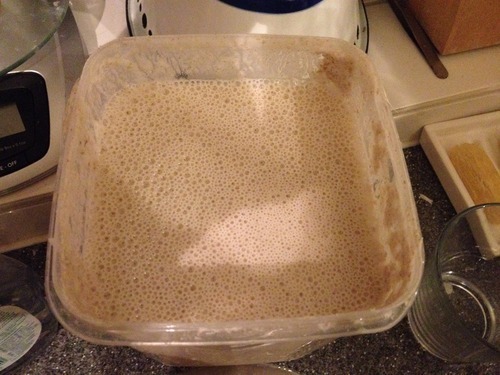
So, this is the starter I used for my Christmas bread. I have been using it since August or so and it renders a wonderful flavor for my breads and yeasty goods. Since I do not bake daily, I feed it once a week. That is something else worth mentioning, a sourdough starter is a living culture. It requires care so that it can keep on working its wonder.
For the breads, I followed this recipe pretty much to the letter. (Incidentally, this other one, is a very good recipe for those who speak Dutch and work with regular yeast) The only adjustment I made (if one can call it such) is that I used 50% more of all ingredients because I wanted to make three breads instead of two. The extra one was so that I could taste it today rather than let it mature as required. I wanted to make sure I did not inflict something awful on my family’s Christmas day. The remaining two are already packed as the recipe instructed. One of them is a gift for my next door neighbor who is the most wonderful neighbor one can hope for, regularly taking care of my animals when I am away. I wanted to bake him something that, at least, equaled the kindness he has for my pets (really, both my cats and dog love him which is rare given their grumpy tendencies).
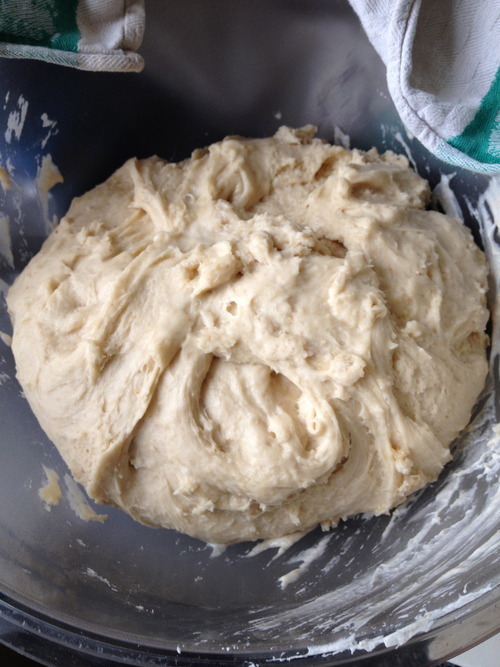
This is a photo of the finished dough about to start its first rise.
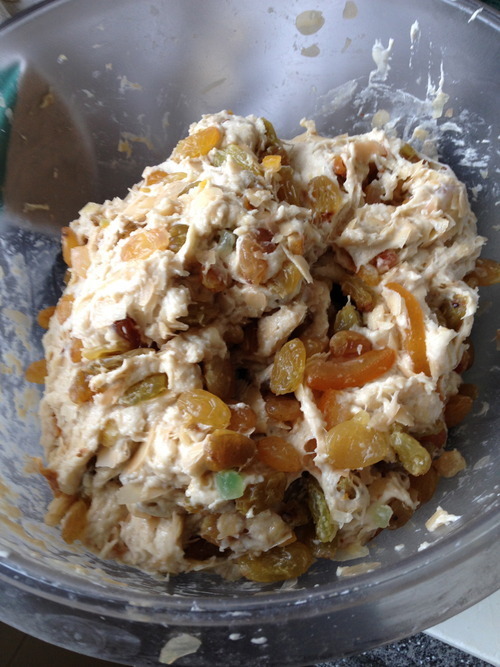
Second rise, the dough with fruits mixed in.
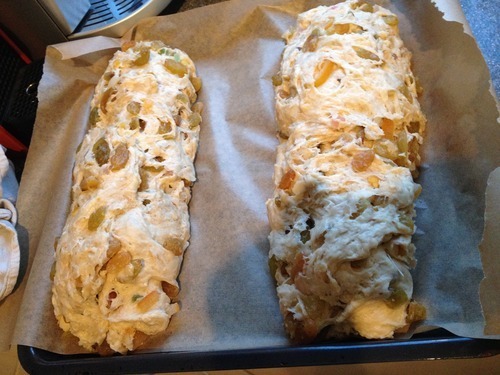
The breads already shaped for third rise.
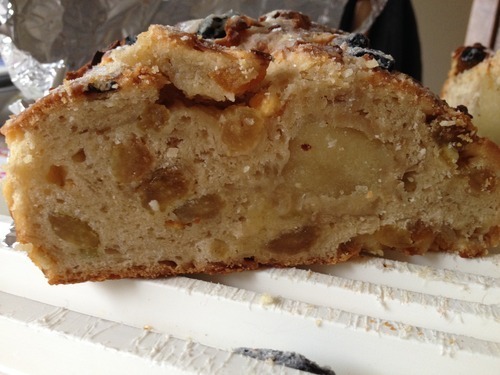
Sliced, with almond paste (or amandelspijs, as it is called in Dutch) in the center.
So, those who made it this far reading, one word of caution: making these breads takes a lot of time and the ingredients are not cheap. I am incredibly lucky that there are many markets in Amsterdam where this stuff is available at reasonable prices but I know this is not the case for everyone. I am also deeply grateful that I can celebrate winter, my favorite season of the year, with something I created myself. Life; for once, I wanted to focus only on that.
For the past decade and a half I have been making all my content available for free (and never behind a paywall) as an ongoing practice of ephemeral publishing. This site is no exception. If you wish to help offset my labor costs, you can donate on Paypal or you can subscribe to Patreon where I will not be putting my posts behind a lock but you'd be helping me continue making this work available for everyone. Thank you. Follow me on Twitter for new post updates.

